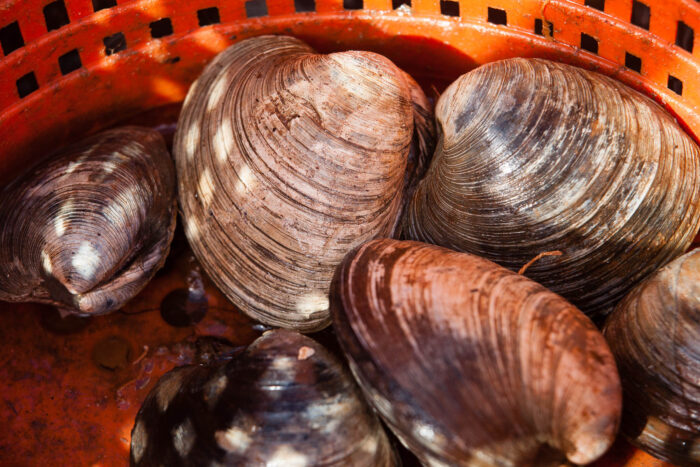Hard clam
Mercenaria mercenaria
The hard clam is a bivalve with thick, ridged, rounded shells. It lives in the salty waters of the lower Chesapeake Bay.
This section shows one large critter image at a time. Use the thumbnails that follow to select a specific image to display here.

This gallery contains a grid of small thumbnails. Selecting a thumbnail will change the main image in the preceding section.
Appearance
The hard clam's thick, rounded shells vary in color from brownish to gray or whitish and can grow to 4 inches or longer. Concentric ridges appear on the shells, which are joined at the hinge by a thick, brown ligament. The shell's interior is usually white with dark purple patches. A hatchet-shaped foot and two short siphons periodically extend from inside the clam.
Feeding
Like many bivalves, hard clams are filter feeders. It uses its foot to bury itself just below the surface of the sand or mud. While buried in the sand, the clam’s two siphons stick up above the surface. The clam draws in water through one siphon, filters out plankton from the water, and eject unused water and particles through the other siphon.
Predators
Adult clams have many natural predators, including gulls, tautogs, waterfowl, cownose rays, blue crabs and oyster drills. Humans harvest hard clams to eat recreationally and commercially.
Reproduction and life cycle
Spawning occurs between May through October, once clams produce ripe gametes and water temperatures rise above 68 to 73 degrees. Females can release between 16 and 24 million eggs per spawn. Eggs are fertilized in the water column. Free-swimming larvae develop over 1 to 2 weeks.
During this time they grow a foot, which is used to crawl over and “explore” a surface before settling. When larvae find a suitable place to settle, they anchor themselves using thin threads secreted from a gland on their foot. Larvae slowly metamorphose into juveniles, developing gills, siphons and digestive viscera. Hard clams may live as long as 40 years.
Did you know?
- Also known as quahogs, little necks, cherrystones and chowder clams. The various commercial names are based on clam size.
- Native Americans used hard clam shells as wampum, white shell beads used in traditional ceremonies or often traded as currency.
Sources and additional information
- Life in the Chesapeake Bay by Alice Jane Lippson and Robert L. Lippson
- Chesapeake Bay: Nature of the Estuary, A Field Guide by Christopher P. White
- Maryland Fish Facts: Hard-shell Clam – Maryland Department of Natural Resources
- Animal Diversity Web: Mercenaria mercenaria – University of Michigan Museum of Zoology
